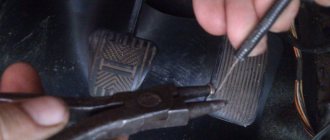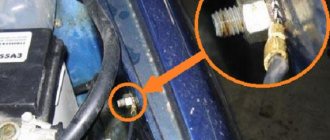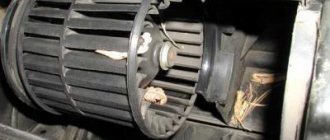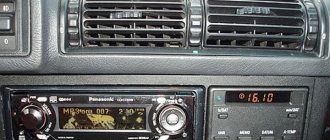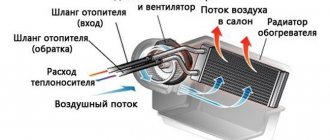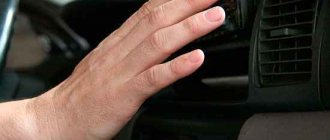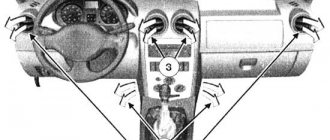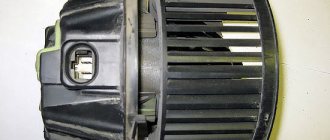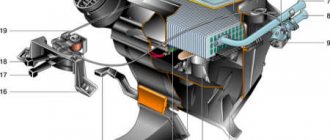Types of faults
First, let's figure out how the stove works in a car. A radiator is installed inside the car, connected to the engine cooling system. The antifreeze heated in the engine, passing through the heater radiator, gives off heat. A fan is installed nearby, which drives air through the radiator, while the air heats up and, already hot, flows through the air ducts into the cabin.
The design of the cooling system in a car
There are several types of stove malfunctions:
- no air flows;
- The stove heats up weakly.
There are reasons for each of them.
Water pump
If the stove blows cold air at idle, then the cause of the malfunction may be worn impeller blades.
This mainly happens when the car is no longer fresh or different coolants were used in the system. What is happening at this moment? A worn pump impeller at low engine speeds cannot create optimal pressure in the system for full circulation of antifreeze. To fix this problem, you simply need to replace the pump.
Why doesn't it blow at all?
This can happen in two cases: the stove fan does not work, or the air does not pass through. The operation of the fan is usually audible, so there should not be any problems in determining the cause. If you can hear the fan, but no air flows, it means that its path is blocked by dampers that control air flow, or by foreign objects, for example, leaves. Rarely seen. To eliminate the cause, you need to check all the air ducts. Debris accumulates near a large obstruction, such as a radiator.
Dirt in the car radiator
If there is no debris, you need to check the dampers. Most often, their drive fails, for example, the cables jam or jump out of their fastening points. What needs to be corrected in this case can usually be seen after disassembly. Violation of the tightness of air duct connections is a very rare problem. The air flow does not reach the blowing nozzles, but is blown inside the dashboard. Here you need a sequential inspection of all connection points. If the cabin filter is very dirty, air passes through it with great difficulty. The interior is not ventilated properly.
You just need to change the filter. Of course, if you changed it recently, it has nothing to do with it. Another reason that the air does not flow: the fan is spinning in the wrong direction. But this only happens if something was done to it, for example, it was changed and installed incorrectly. In such a situation, you need to check the polarity of the fan connection (plus to plus, minus to minus).
Heater replacement
As a rule, the stove radiator is replaced in two cases: when it cannot be restored due to clogging or if it is rotten and has a leak. It happens that even a new heating part can leak. This is mainly due to poor quality materials of the purchased product.
You can replace the stove radiator at home. To do this, you need to follow the sequence of the repair process. It is important to note that repairs are easier to carry out with a partner. This paragraph indicates the process of dismantling and installing the Kalina stove.
Step-by-step dismantling process:
- First you need to drain about three liters of coolant.
- To easily dismantle the radiator, remove the accelerator pedal and lift the brake pedal as high as possible.
- The steering column is removed. First, remove the protective panels from the speaker. Then disconnect the electrical wiring plug from it.
- We disconnect the parts of the intermediate universal joint of the steering mechanism and unscrew the mounting bracket from the body. After this work, remove the entire steering column.
- We remove the “toad” of the stops, located on the right side of the brake pedal.
- Now, by hanging the brake and accelerator pedals in the upper position, we are able to access the radiator.
Before removing the stove, the following work must be carried out from the engine compartment. We remove the battery, its installation cavity and the base bracket. We disconnect the air filter pipe and bend it towards the passenger compartment. Then unscrew the coolant pipes from the fittings of the interior heater radiator. When removing the pipes, antifreeze may leak from the stove, which remains there in small quantities.
Working from the interior side, using a hacksaw blade for metal, we saw off the plastic pipes. Then the Kalina stove is removed along with the seal and metal protection element.
Why doesn't the heater fan work?
Heater fan not working
The stove fan does not work if:
- The fan fuse has blown;
- The heater switch is faulty;
- Problems with wiring, connection reliability;
- The fan motor has failed.
The simplest thing is a blown fuse. In this case, simply replace it with a new one. However, if the fuse burns out again, you need to look for the cause, a short circuit somewhere. The fan switch can be easily checked by shorting the wires that go to it. Find out which terminals of the switch should close and jump the corresponding wires. The fan started spinning - the problem was found. Switches are usually non-removable, so replace the one that is faulty immediately.
Article on the topic: The best cars of the USSR
Problems with wiring rarely occur, but if in doubt, check that all connections are secure and that there are no oxidized contacts or broken wires. If suspicions for all of the above reasons are not justified, it means that the motor itself is faulty. It is also usually beyond repair and will need to be replaced.
Faulty heater motor must be replaced
Preventing the operation of the stove in the car
In order for the stove in your car to heat well and not let you down at the most inopportune moment, you need to follow a few simple tips.
- Keep the radiator clean. Light contamination from the outside of the radiator can be removed with a vacuum cleaner. Flushing the engine cooling system, with which the heater radiator is inextricably linked, will help get rid of internal deposits and blockages in the channels.
- Use good antifreeze . High-quality antifreeze is the key to long-term operation of not only the stove in the car, but also the engine. Remember this and do not forget to replace it in a timely manner.
- Change the cabin filter more often . A clogged cabin filter will certainly create problems not only for the operation of the stove, but also for the air conditioning and cabin ventilation system as a whole. In addition, dust and pollen deposited in the filter can pose a serious health hazard (especially for allergy sufferers).
If, at an outside temperature of minus 25 °C, your car’s heater heats the interior to +16 °C from below and up to +10 °C from above, then it can be considered quite serviceable. To avoid problems, it is recommended to carry out preventive measures in a timely and responsible manner that will allow you to enjoy a comfortable ride in a well-warmed-up car.
And remember, the longer the service life of the machine, the more attention its heating system requires. This applies to all cars, regardless of country and manufacturer.
Why the stove does not heat well - cooling system malfunctions
This group of breakdowns not only affects the heat in the cabin, but also interferes with the normal operation of the engine. Therefore, she needs to pay special attention.
Thermostat
Cooling circuits in a car
One of the most common breakdowns is thermostat failure. The thermostat is a "switch". It determines the path along which the coolant moves. If it breaks and antifreeze is constantly pumped through the main radiator, the engine will warm up for a very long time, and at low temperatures it will not heat up at all. To find out that the thermostat is faulty, firstly, you need to look at the coolant temperature gauge. In the event of a breakdown, the temperature does not rise for a very long time. Secondly, you need to touch the hose coming from the main radiator. The hose should begin to heat up after the engine warms up, when warm air comes out of the stove. Otherwise, the thermostat needs to be replaced.
water pump
Another common malfunction of the cooling system is the ineffective operation of the pump, that is, the pump pumping antifreeze. The pump stops working normally in the following cases:
- its drive is faulty (the belt is broken);
- it is jammed (the bearing has failed);
- the impeller (blades that drive coolant) rotates;
- The impeller has collapsed and is no longer pumping as efficiently.
The consequence of this will be that in one place of the system it will be hot and in another cold, the engine will overheat, which you will see on the coolant temperature indicator. If the water pump still pumps, but with less efficiency, the heater will heat only at high speeds, since an insufficient volume of liquid for normal heating passes through the heater radiator at idle speed, and cold air blows from the heater.
Cylinder head gasket
If the gasket located between the cylinder block and its head is broken or burned out, gases from the cylinders enter the antifreeze. Signs are white smoke coming from the exhaust pipe and a sharp rise in the coolant level, gurgling in the expansion tank. This is a serious problem. You'll have to disassemble the engine.
Air entering the system
If the stove heats only at speeds above idle, this is a clear sign that there is air in the cooling system. The thermal conductivity of air is low, so it cannot transfer heat quickly. This adversely affects not only the operation of the heater, but also the entire engine as a whole. The design of the stove is such that its radiator is the most likely place for air to accumulate. If the intensity of coolant movement is not enough, the air is not expelled from the radiator by antifreeze, for example, at idle, and the stove does not heat up.
Article on the topic: Car rental in Russia
The heater in the car blows cold air
A sure sign that air has got in: the heater does not heat well at idle, and when the speed increases, gurgling, fluid overflowing is heard in the heater area, and hot air begins to blow. We need to find out why air got into the cooling system. This could be if the system is leaking somewhere and air is being sucked in. The cause may also be a low amount of coolant. Before adding coolant, be sure to find and eliminate the reason for its disappearance. If after replacing the radiator of the stove it does not heat well, the problem, again, is air getting in. How to properly remove air from the system, see the information specifically for your car. To get rid of the air lock in the heater radiator, disconnect the hoses from it, and pour antifreeze into the upper one, and drain it from the lower one, and continue this until air bubbles stop coming out along with the liquid. On some models, to get rid of air in the cooling system, it is enough to stand at a certain angle to the horizon and let the engine run at speeds above idle.
Interior heater. Work and device
The vehicle interior heating system includes an electric fan, cooling fluid supply and circulation pipes, a radiator, shut-off valves, air ducts and air dampers. The heating element is located in the front panel housing.
Two pipes are connected to the radiator body, through which liquid flows into it. The movement of coolant is carried out under the influence of the operation of the water pump and the cooling system of the power unit. When the engine warms up, a heat exchange process occurs. Antifreeze takes excess heat from the engine, thereby cooling it. When the shut-off valve is open, hot coolant enters the heater radiator housing, at the same time the electric heater fan blows cold air onto it. Thus, the radiator gives off its heat to the air flow, which, when warm, enters the car interior.
For the system to operate effectively in winter, the engine must be warmed up well. Thirty degrees is enough for the heater to supply warm air into the cabin. Turning on the system immediately after starting the engine will only increase the warm-up time of the engine and the interior itself.
Experienced drivers recommend turning on the VAZ heater fan when the coolant temperature reaches fifty degrees. This indicator is most effective when warming up the car in the morning in cold weather, both the engine and the interior. Otherwise, you risk wasting valuable time and wasting fuel.
Heating system malfunctions
If there are no complaints about the operation of the cooling system, then the reason is in the stove itself. That is, hot antifreeze is supplied to it, but cannot pass through it and transfer heat to the interior. There are two obstacles to this: the radiator and the heater tap.
Heater radiator
Clogged heater radiator in a car
Another reason why the heater in the car does not heat is that the heater radiator is clogged. Hot antifreeze cannot pass through it, and, naturally, does not heat up. This happens if:
- A variety of cooling system sealants were used;
- The car was operated for a long time on low-quality antifreeze or water;
- The radiator, like the car, is many years old.
All this leads to the accumulation of dirt in the cooling system. The heater radiator has one of the narrowest channels, the fluid flows there slowly to give off more heat, so it suffers first of all. In this case, it is necessary to flush or replace the heater radiator.
Faucet
Another reason why liquid does not flow through the radiator is a closed heater tap. As a rule, it is present only on older car models. There are two reasons: the tap itself is faulty, for example, it gets stuck in the closed position, or the drive to control it. The drive, usually a cable, has most likely come off its mounts. Then it needs to be secured. The heater valve assembly is replaced.
Faucet in the heating system in a car
On modern cars there is no faucet, but there is a damper that closes the heater radiator if hot air is not needed. A breakdown of the drive of this damper or its jamming also leads to the fact that the stove in the car does not heat well.
Airlock
As a rule, air enters the system when some elements of the system are depressurized, as well as when the amount of cooling liquid in the expansion tank is critically reduced. How are these problems resolved?
The first thing you need to do is check the antifreeze level in the expander. This process should only be carried out on a cold engine. The amount of liquid should be within the maximum mark, but in no case exceed this figure.
If the antifreeze level is below the minimum mark, then it should be topped up. If the level drops frequently to the minimum or until the expander is completely empty, a leak may occur. In this case, it must be urgently eliminated. Air pumping should be done as follows. Place the car on a flat surface, remove the cover from the expander. After this, start the engine and, increasing the speed several times, add antifreeze.
Dirty cabin filter
And the tenth reason for poor stove performance is a dirty cabin filter. A dirty filter reduces flow. It also needs to be replaced with a new one.
Well, that’s all, we have looked at the main causes and malfunctions of poor stove operation. I would also like to add that in many cases the thermostat is the culprit for poor heater performance, so pay attention to it.

